What does indoor calla lily look like and how to grow it correctly?
Some flowers in bouquets look beautiful and stately. Among the plants that are popular among florists, calla can be distinguished, striking for the impeccable purity of the flower. The plant is called both calla and arum. Calla belongs to the Aroid family and is cultivated both in the garden and indoors.
Although calla lilies belong to unpretentious plants, but you need to know the approach to them, otherwise they will not endow with the beauty of their flowering. Namely, because of the original shape of the flower, the plant is kept in pots, grown in flower beds. Calla lilies came to us from the swampy places of southeast Africa. In the wild, the plant is rare, but it is cultivated everywhere.
Content:
- What does the plant look like?
- Conditions for keeping a flower
- Reproduction and planting
- How to properly care for calla lilies?
- All about plant transplant
- Possible growing problems
What does the plant look like?
Decorative perennials - arum can be divided into two groups. In some, food comes from tubers, while others - from rhizomes. Tuberous calla lilies are diverse in color of inflorescences, their sizes. Rhizome species of flowers have such external features as inflorescences with a white veil around a yellow cob.
Varieties with yellow, black, red and pink bracts were bred.
Leaves on long petioles extend from the rhizome. The leaf plates of the calla are arrow-shaped, bright green in color. In length, the leaves reach from 6 to 14 centimeters with a width of 5 to 11. In some plant species, silvery specks are visible on the leaf plates.
Arum inflorescence is located on a leafless stem. A white, funnel-shaped blanket around the ear, covered with miniature flowers, is the decorative part of the calla lily. Ethiopia is considered the birthplace of the white flower. It is this type of plant that is most common, and it is found in wedding bouquets. In order for the calla to bloom, it is necessary to create certain comfortable conditions for it.
Conditions for keeping a flower
The successful development of calla arum, its flowering depends on many conditions:
- The best composition of the soil substrate will be sod land with the addition of one part of leafy soil and humus. For looseness, add a little coarse sand. Rhizome calla lilies are more suitable for a soil mixture consisting of an equal amount of humus, sand, leafy earth and two parts - sod. Adding clay will not hurt either. For three liters of substrate, you need a tablespoon of superphosphate.
- In their natural environment, Aroids prefer shady places with high humidity. Therefore, the brightness of the sunlight will burn the leaves of the plant. It is best to place indoor flower pots on the west or east side of the house. Diffuse lighting should be on for 12 hours. In winter, you can organize additional lighting of calla lilies phytolamps.
- The optimum temperature for keeping room calla lilies will be 18-22 degrees Celsius. During the rest period, the temperature level is reduced to 10-13 degrees.
- A humidity of 70-80 percent is a prerequisite for the successful growth of a flower.
For colorful calla lilies, the air temperature can be 24 degrees, and the humidity is 10 percent lower than that of whites. Correctly selected conditions will help calla lilies to develop rapidly and bloom annually.
Reproduction and planting
There are several methods for propagating room calla lilies:
- Young plants appear around the mother flower, which are separated and transplanted into a separate container. In order for the plant to grow stronger in a new place, it is placed in nutritious and loose soil, watered abundantly and sprayed in the first seven days.
- Colored calla lilies are propagated by tubers, which are buried in the ground to a depth of 6–12 centimeters. You can cover the pot with plastic wrap, regularly airing and moistening the ground.
- The qualities of varietal calla lilies are preserved when propagated by seeds. The planting material is exposed to a biostimulator for 6 hours. Having spread the seeds on a damp linen napkin, they are determined in a warm place. As soon as the seeds germinate, they are placed in a container with soil. Seedlings are planted in a permanent place when they grow up and get stronger.
Planting of both the layering of the plant and the seedling is carried out when the roots are formed. If a tuber is planted, then they pay attention to the presence of a kidney and the absence of damage. The calla lily container needs a spacious one.
An adult plant will have a comfortable pot with a diameter of 40 centimeters and a height of half a meter.
A drainage layer is laid out on the bottom. It can be expanded clay or pebbles. Then it is filled three-quarters with nutrient soil. The plant is placed in a hole and sprinkled with earth, lightly tamping. It remains to add soil to the pot and water the plant with water at room temperature. When the calla lilies are planted correctly, the plant will begin to develop rapidly.
How to properly care for calla lilies?
Watering is important for indoor culture. A moisture-loving perennial will not be able to withstand a prolonged drought and will die. Water abundantly when the topsoil has become dry at a depth of 1 centimeter. Instead of watering, you can leave water in the pan or put wet moss there.
The nutritious soil helps the calla to develop until it becomes poor in useful microelements. To enrich the substrate, add mineral fertilizers every two weeks along with watering. Foliar dressing is also helpful. The leaves are sprayed with solutions with the addition of superphosphate, potassium, nitrogen. As an organic matter, especially during the flowering of calla lilies, tea leaves and fruit peels are added to the soil.
You can water the plant with water infused with eggshells.
In order not to often transplant a flower, they remove the top layer of soil in the container and replace it with another one with nutrients. During the dormant period, calla lilies are watered and fed to a minimum. In order for the plant to bloom, it needs to be given a two-month break in development. It is not difficult to take care of an indoor perennial. We need to see his problems, what he lacks, and fix the situation.
All about plant transplant
Calla lilies find it difficult to feed and develop without replacing the soil. Even replacing the top layer of soil in the pot, you cannot achieve successful flowering of the plant. Need an annual calla lily transplant.
Before the active period of the plant's life, in early spring or at the end of winter, a container and soil are prepared for transplanting a flower. It is better not to transplant a weakened plant. It will not be able to survive the stress and will die.
Transplant features:
- The capacity for the perennial is selected more than the previous one. It is better to disinfect it by rinsing with boiling water or weak potassium permanganate solution.
- Drainage is imperative, otherwise stagnation of moisture in the container is inevitable. Part of the pot is filled with prepared or purchased soil. You can saturate the soil with bone meal with phosphate fertilizer by taking a tablespoon per liter of soil mixture.
- The flower is carefully dug out of an old container, some of the young offspring are removed or transplanted into another container. Calla roots are washed under warm running water, damaged, rotten parts are removed.Tubers are cleaned of rot, cut off damaged areas. You can sprinkle the cut site with crushed activated carbon.
- At the end of the procedure, the plant or tuber is placed in the ground, sprinkled with earth and watered. The tubers should be no higher than 4 centimeters from the soil surface.
By replanting a plant annually, they give it the opportunity to receive useful elements in abundance, and protect against diseases.
Possible growing problems
Errors in the content of calla lilies appear on the state of the leaves of the plant. When foliage begins to turn yellow at the end of the growing season, it is a natural process. Calla lilies of different colors lose their leaves after flowering. In white plant species, the leaves should always be green and vibrant.
Consequences of improper care:
- Yellowing of foliage is associated with excessively humid indoor air or, conversely, its dryness. In winter, green "tenants" of apartments suffer from dry air. You can save the plant by placing the pots of calla lilies away from heating radiators. The plant will be saved by constant spraying of the leaves with warm water and containers with moisture placed next to it.
- The stems of the plant become slender and elongate if the flower has little light. In winter, you can transfer the calla lily pot to the southern windowsills. In the summer it will be hot for them there, so a western or eastern location is suitable for the plant. By the burns on the leaves, it is determined that there is a lot of sunlight and it is destructive to the flower.
- Depletion of the soil leads to the fact that the leaves turn yellow, and calla develops poorly, does not bloom. In this case, the leaf stalks break, and the plates become dull.
- Often the flower is affected by fungal infections, which are determined by brown spots on the leaves, by rot on the roots. Besides processing fungicides transplanting into healthy soil will save the plant.
If all the conditions for growing and care are met, then the calla will bloom constantly and decorate the home.
More information can be found in the video:



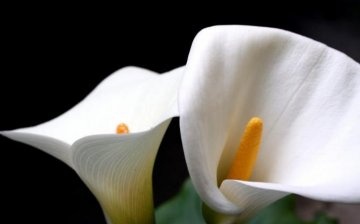


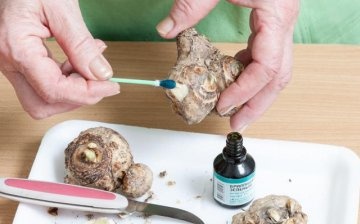
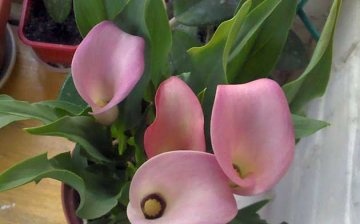
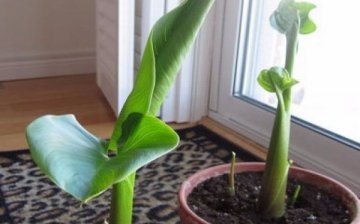
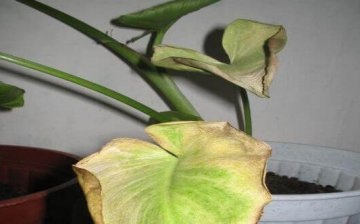







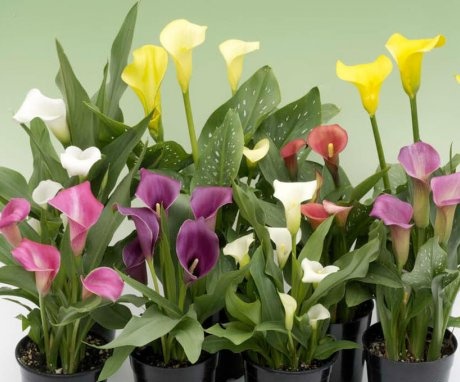

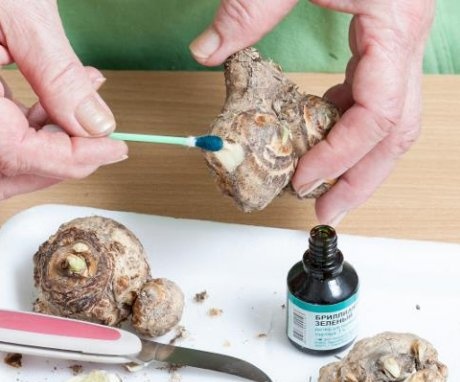
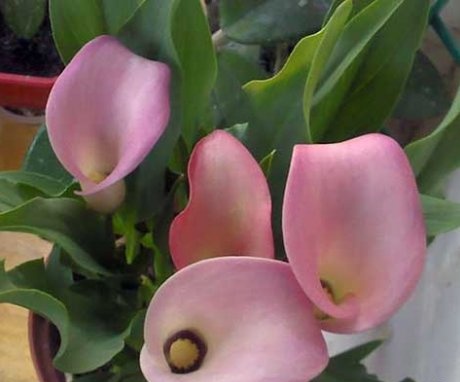
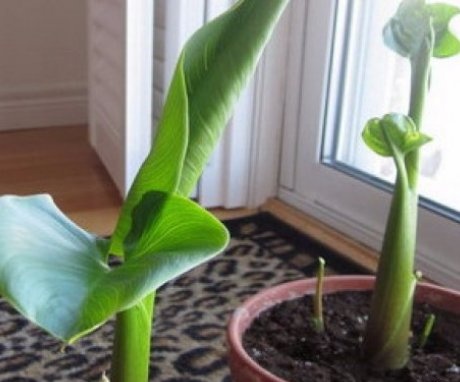
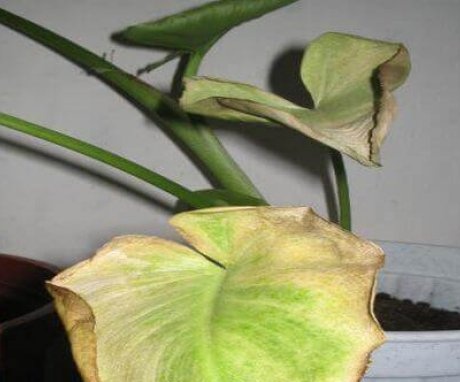
I can't say that calla is my favorite flower, but I really liked the indoor variety. I will definitely get myself such a beauty, I now know how to take care of her. I am sure it will become a decoration for any interior.